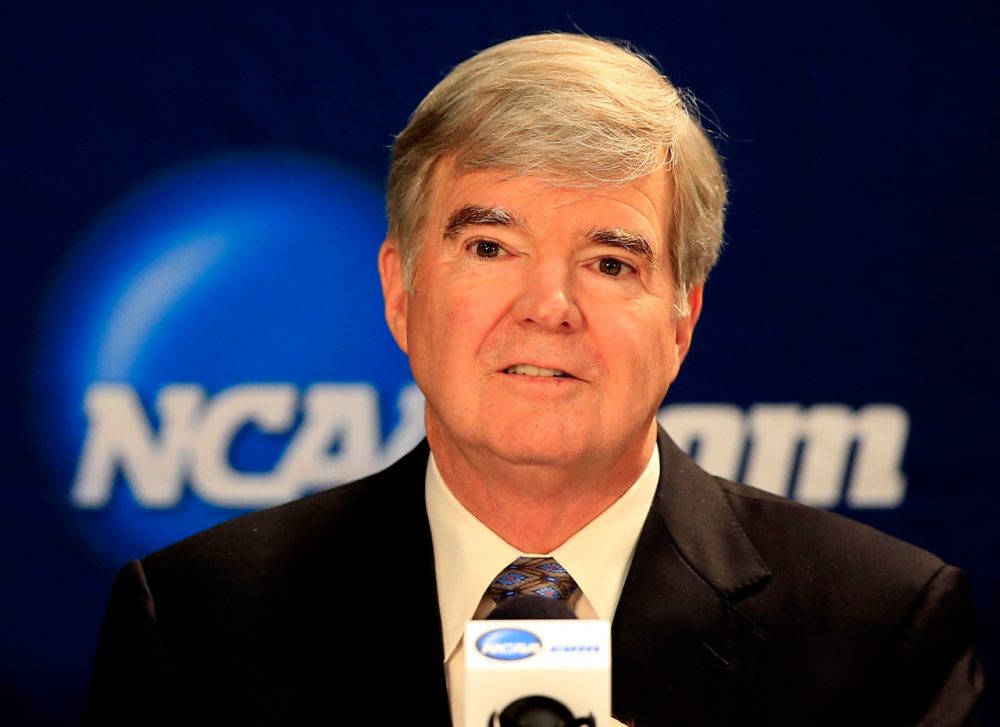Advertisement
NCAA Gives More Power To 'Big Five' Conferences
Resume
On Thursday, the NCAA agreed to a plan that will give the ACC, Big Ten, Big 12, Pac 12 and SEC the authority to make their own rules on select topics. The move comes as the NCAA faces multiple lawsuits, all stemming from the issue of athlete compensation in the collegiate sports industry.
Dan Wolken of USA Today joined Bill Littlefield.
BL: Dan, if this plan gets formal approval, which is expected to happen, what are some of the things the Big Five conferences might be able to do?
[sidebar title="Judge Rules Against NCAA" width="630" align="right"]Yahoo's Dan Wetzel joins Bill Littlefield to discuss the ruling in favor of former UCLA star Ed O'Bannon and his fellow plaintiffs.[/sidebar]DW: The first thing they’re gonna have to do is address the full cost of attendance scholarships. This has been an issue that’s been simmering for a long time. This will free up those five conferences to offer perhaps $2,000, $3,000, $4,000, $5,000 more that would cover incidental expenses, living expenses.
They’re gonna look at some recruiting rules and the rules regarding agents and how much contact they’re allowed to have with athletes; long-term medical insurance; four-year scholarships (currently scholarships at a lot of schools are year-to-year) — a lot of things like that.
BL: Will all of the member conferences of the so-called Big Five have to follow the same rules? Or will they be competing by saying, “We’ll give you more than another school you might be thinking about.”
DW: Even though they’re initiating and being voted on by the five wealthy conferences, the other conferences in Division I all will have the opportunity to adopt the same rules; they just can’t vote on them. So a kid will definitely have to compare the financial package being offered from one school to the next to see if it’s apples for apples.
BL: What was the motivation for this change?
DW: If you want to go back to 2011, Mark Emmert, the NCAA president, proposed a $2,000 stipend for every college athlete per year. That got voted down, a large part because of the smaller schools who didn’t understand how it was going to be implemented, didn’t know if they could afford it. And I think at that point people started to become very frustrated about the fact that there are these 65 schools that all make about $20 million per year just through television money, and they are different than the other 260-something schools in Division I.
BL: In football, the Big Five control a massive revenue stream in terms of television rights and money from the bowls, and they dominate the landscape in terms of success on the field as well, but the NCAA controls the enormous revenues from the men’s basketball tournament. How could the new plan affect that event?
DW: Talking to the college presidents, that’s one of the things they don’t want to change. And that’s frankly a large reason why these schools have tried to stay together. The Big Five, they could have broken off and done their own thing if they wanted to, but they like the model of the big tent, including the men’s basketball tournament.
BL: Dan, there are 65 colleges in the Big Five conferences. You tweeted yesterday:
I still say autonomy doesn't divide the haves and have-nots as much as it divides the haves and have-mores. Schools 40-65 will be crushed— Dan Wolken (@DanWolken) August 7, 2014
Tell me a bit more about that.
DW: There’s really about 20 schools that have fairly vast resources, but the other 45 of those 65, even though they get a lot of revenue, it is being spent in a lot of ways, including debt service on facilities that they built — that’s a large chunk of it. And those schools, when this cost of attendance happens, it’s not like they can just find another extra $2 million in the couch cushions.
When they take these restrictions off, the really rich schools, those top 20, are gonna find ways to get advantages. “School X is offering two trips home per year as part of your scholarship, but we’re gonna offer you five trips home.” And that is going to add up.
More NCAA:
This segment aired on August 9, 2014.